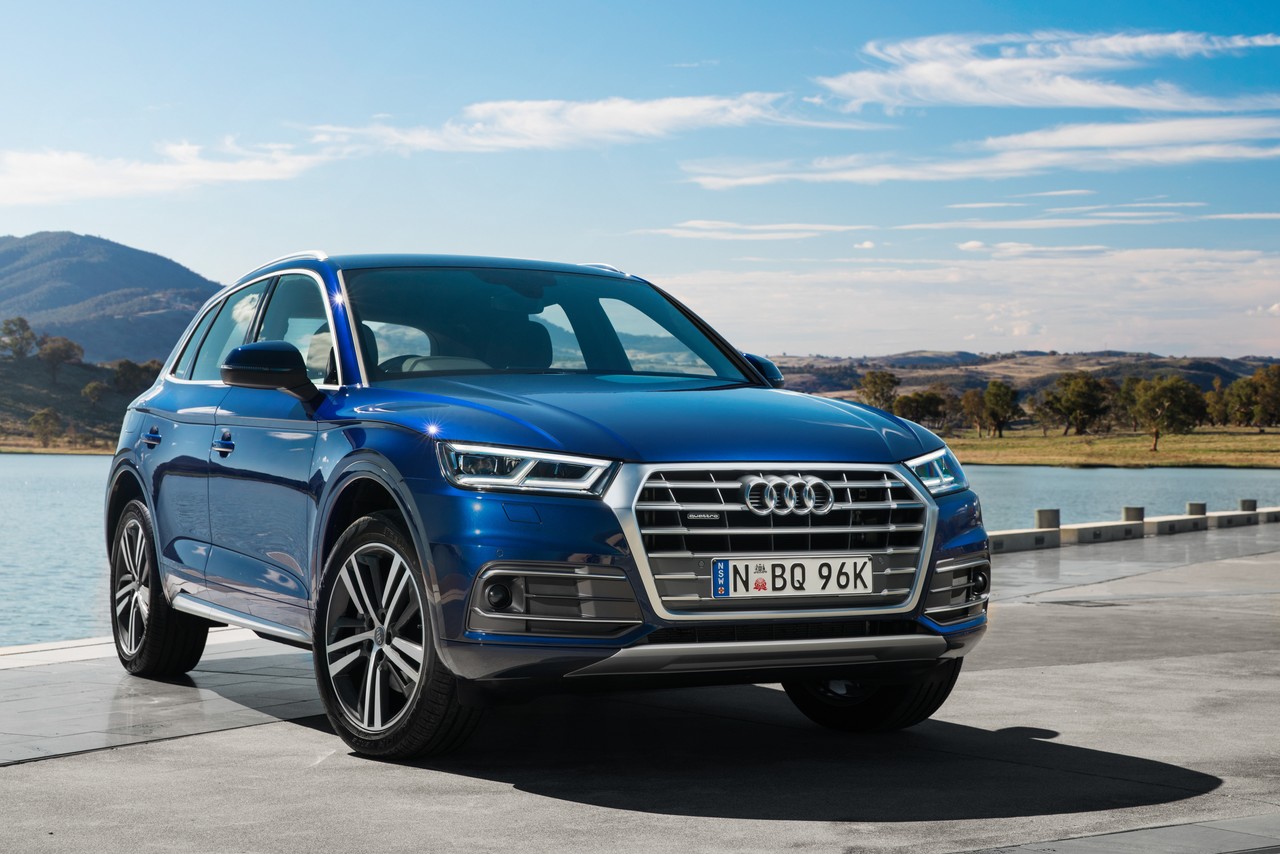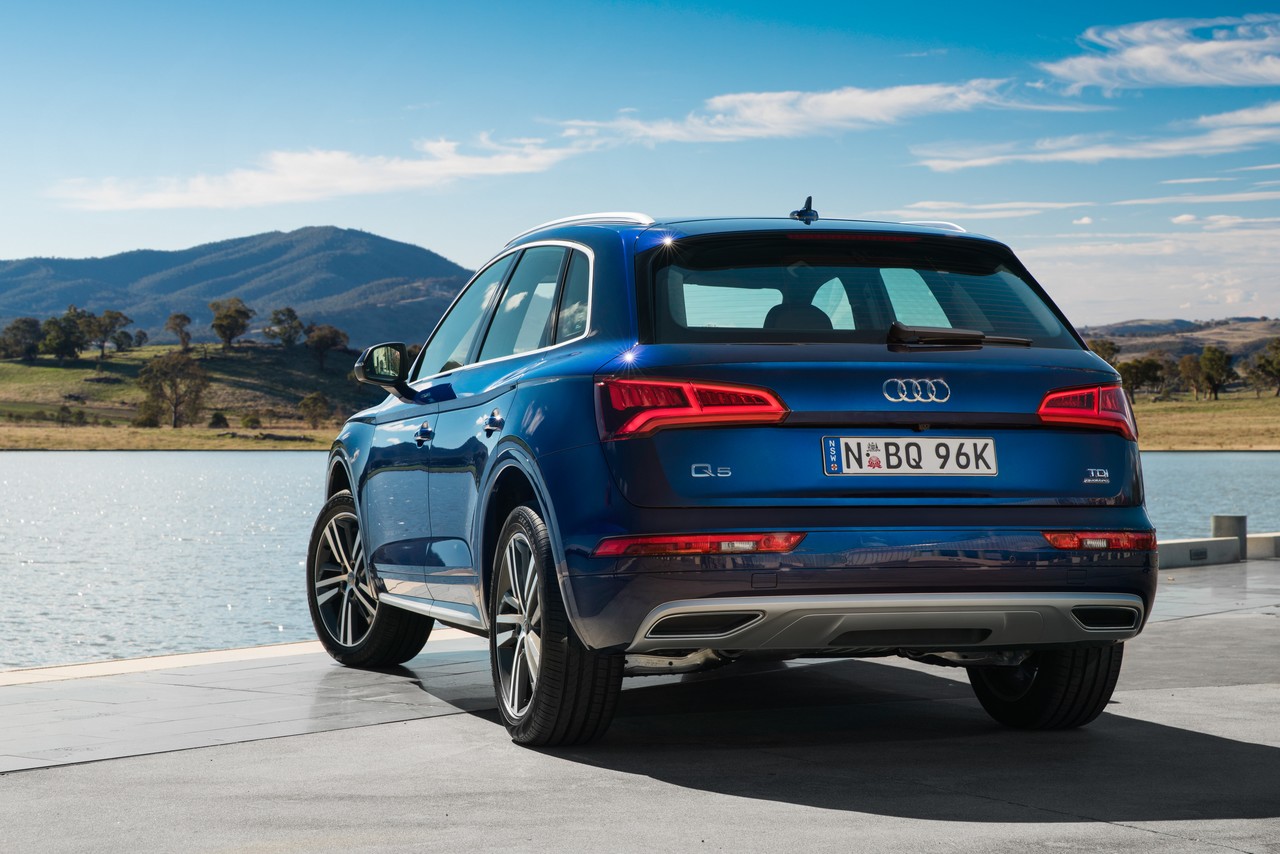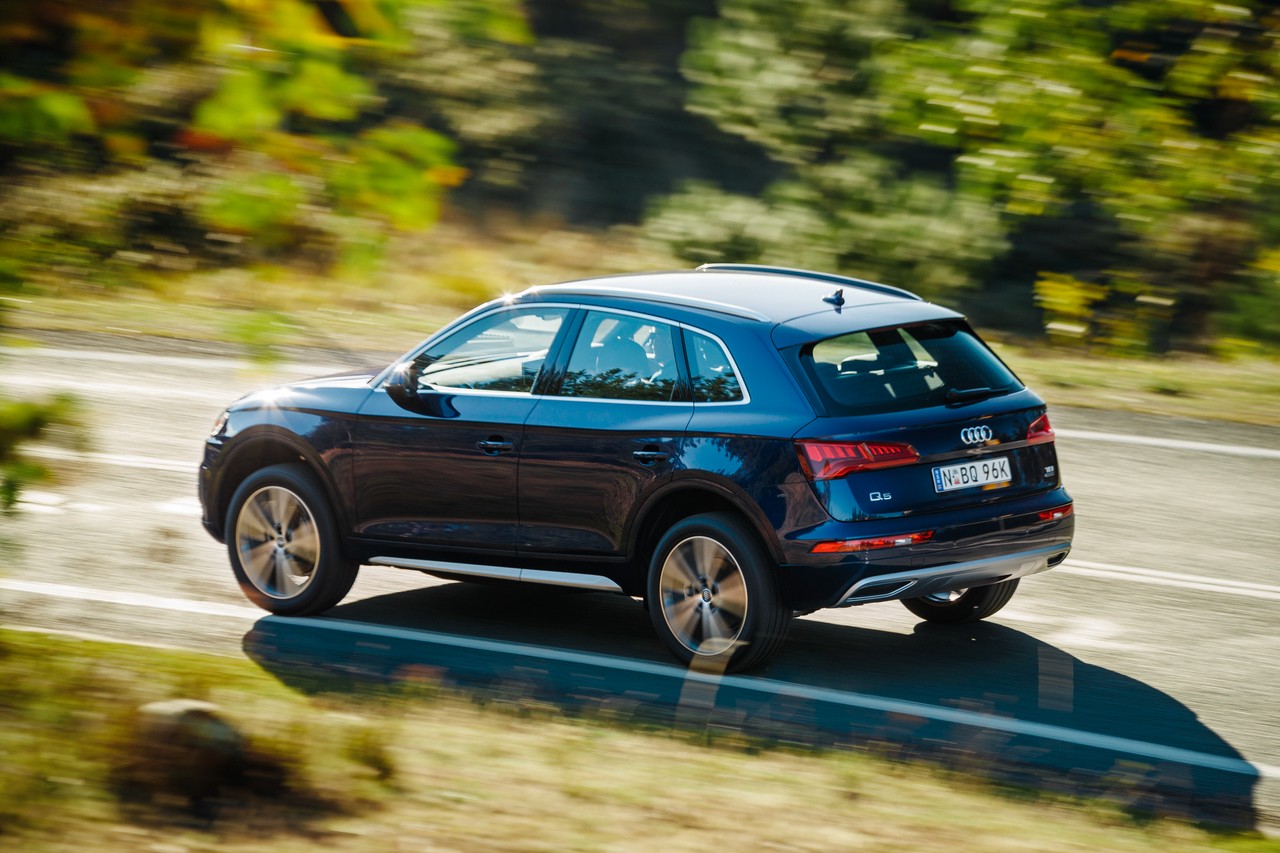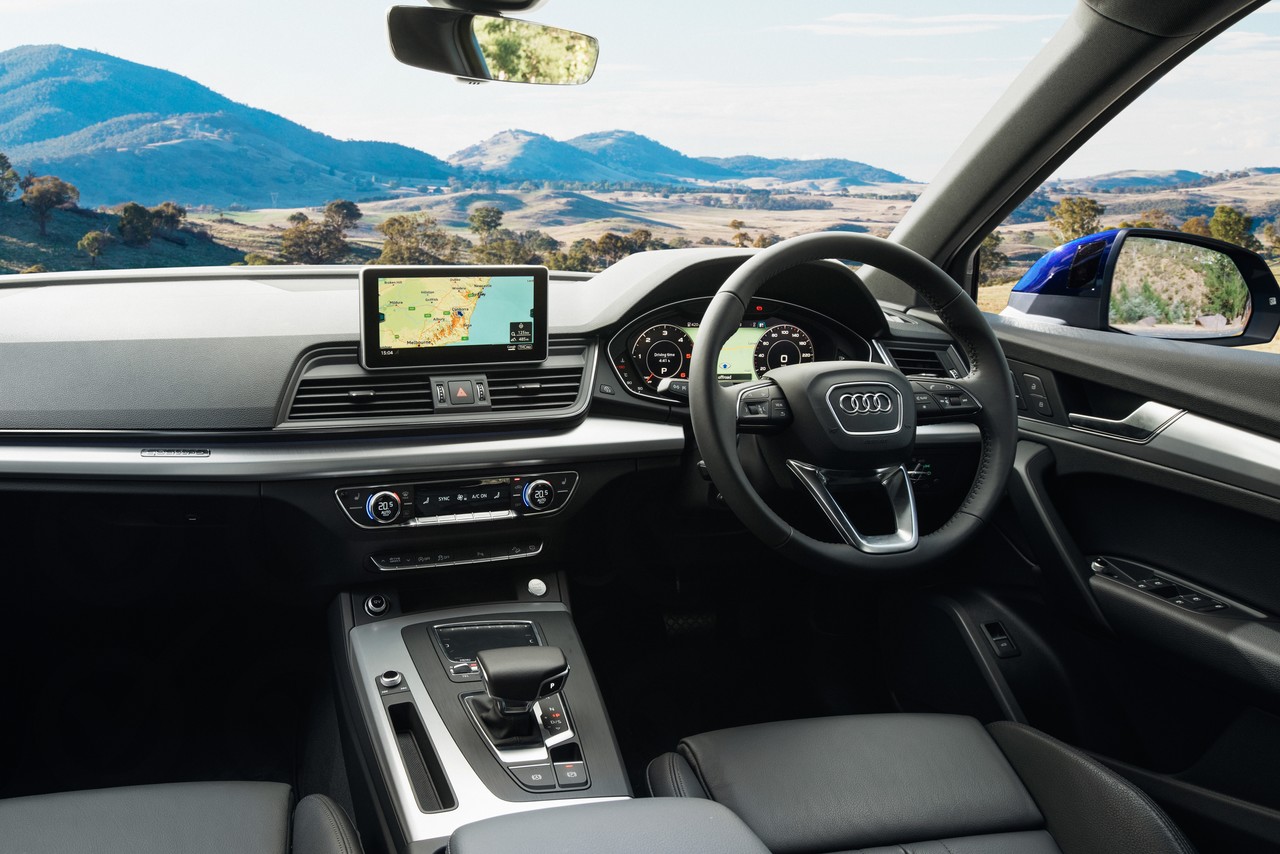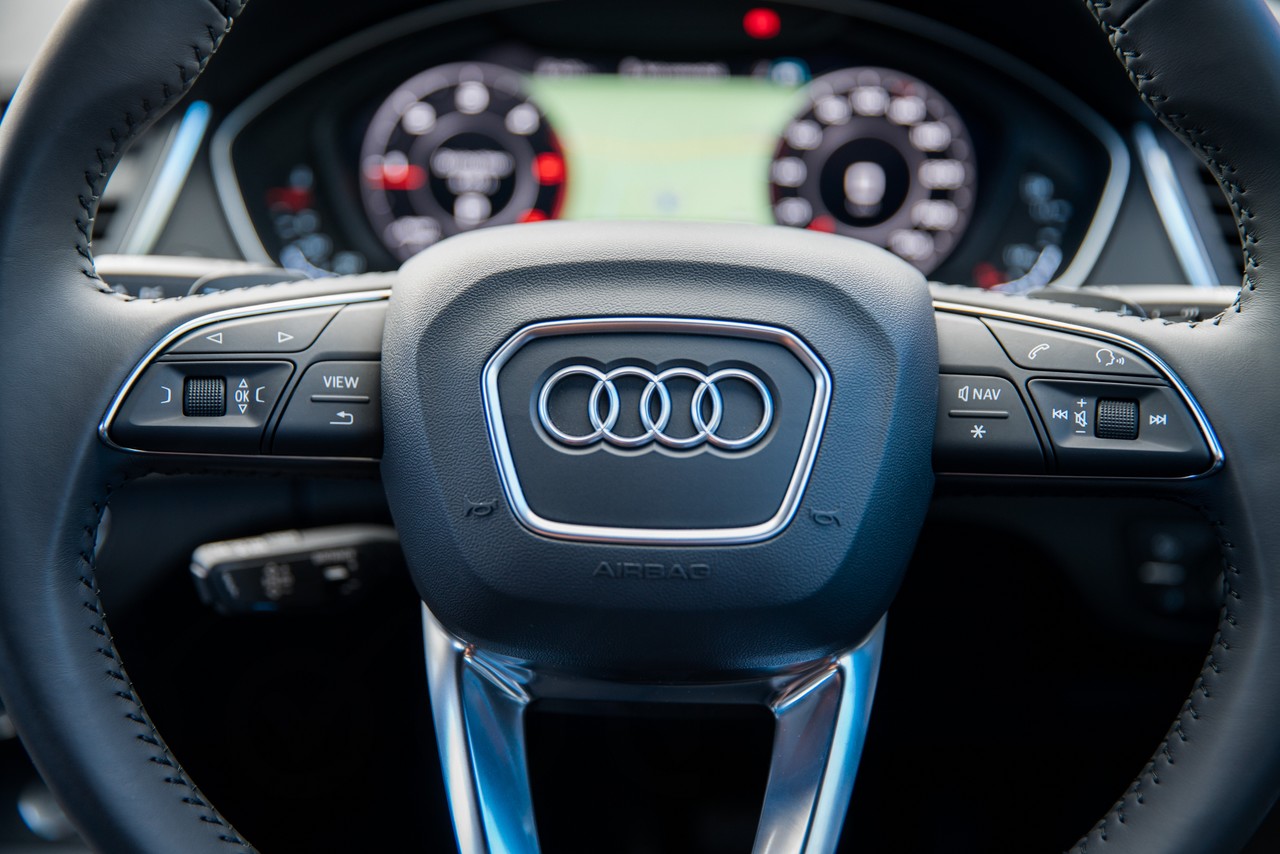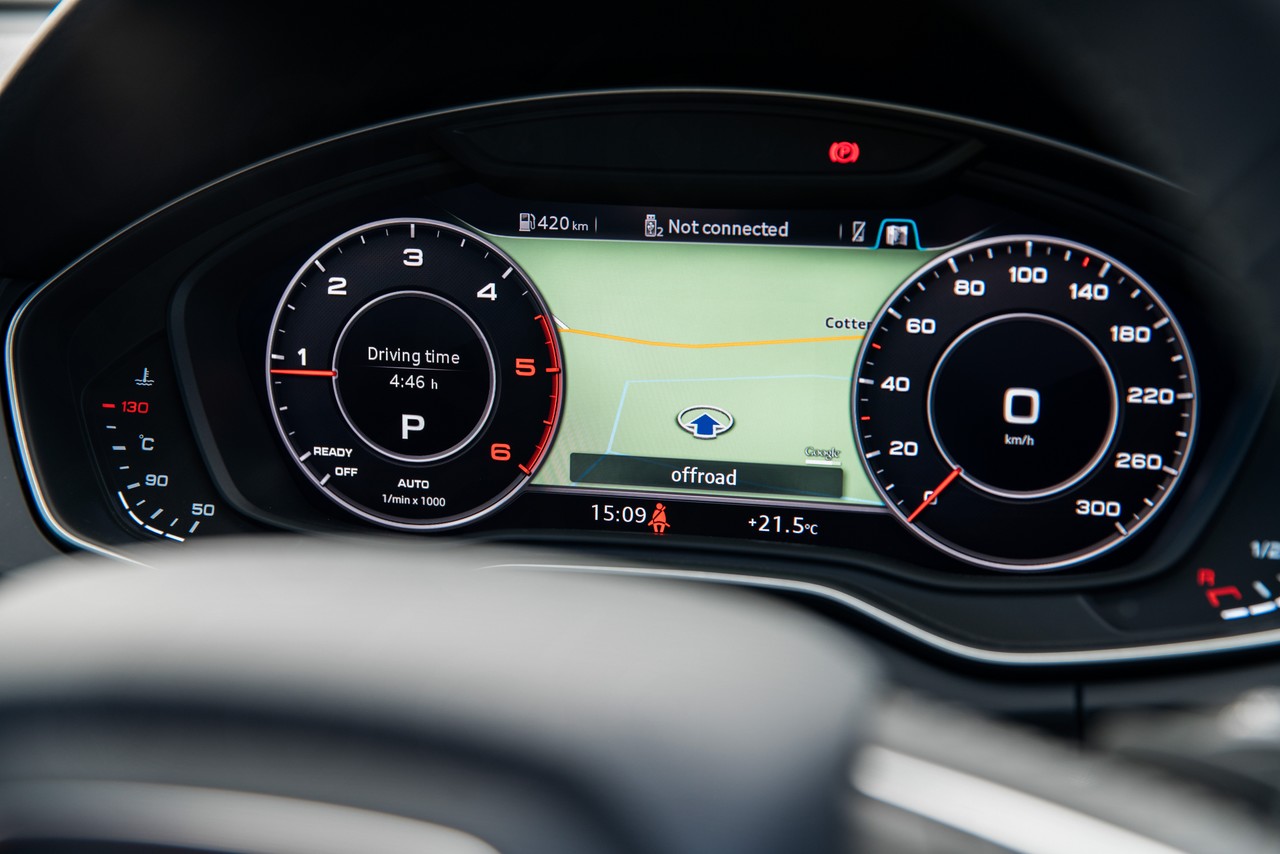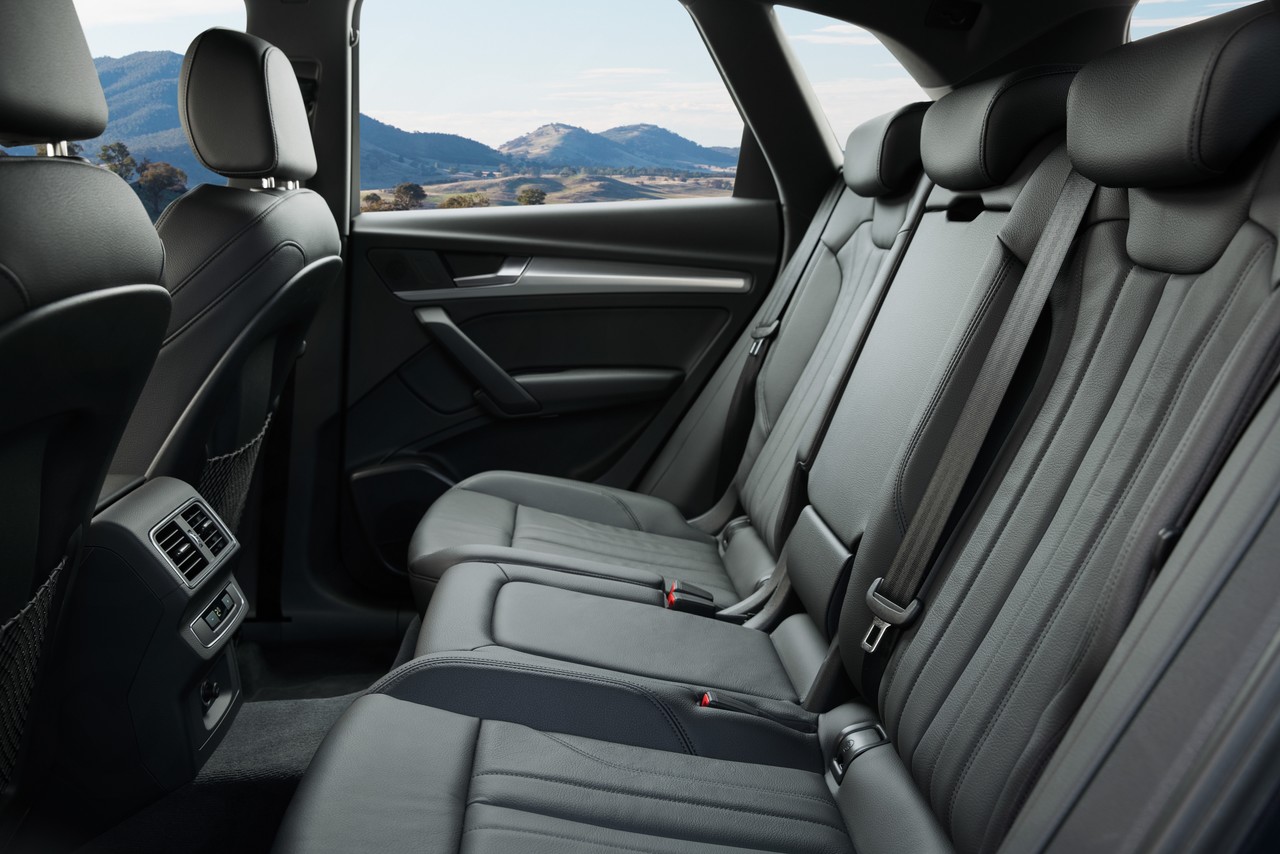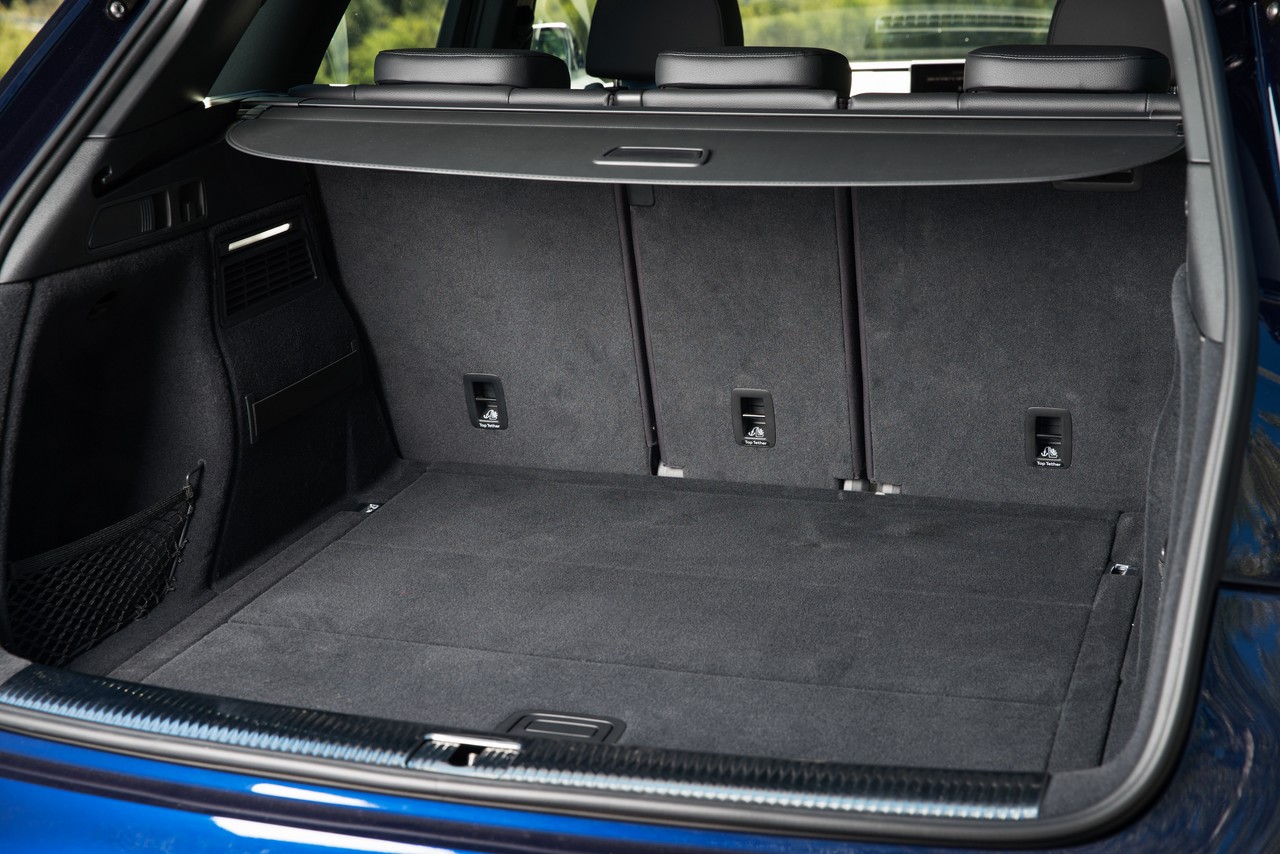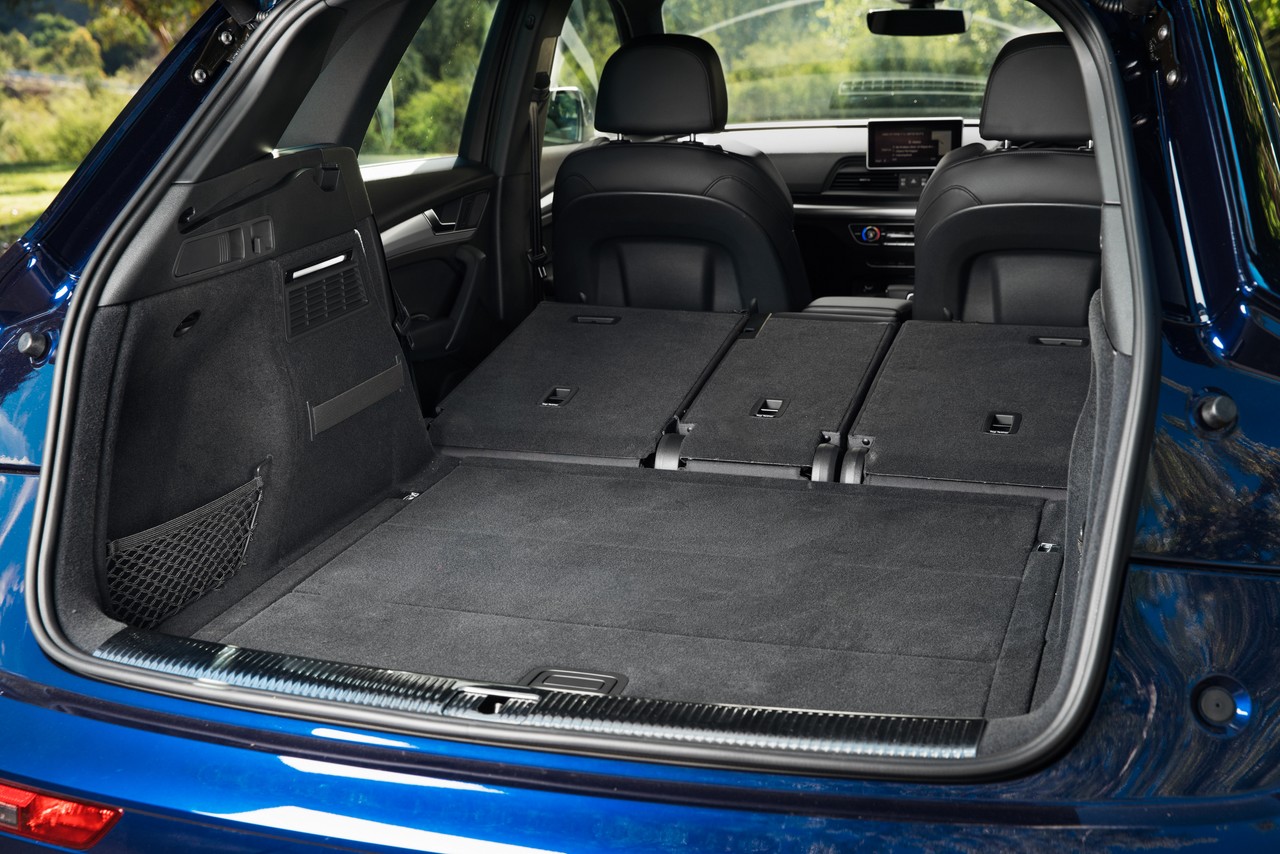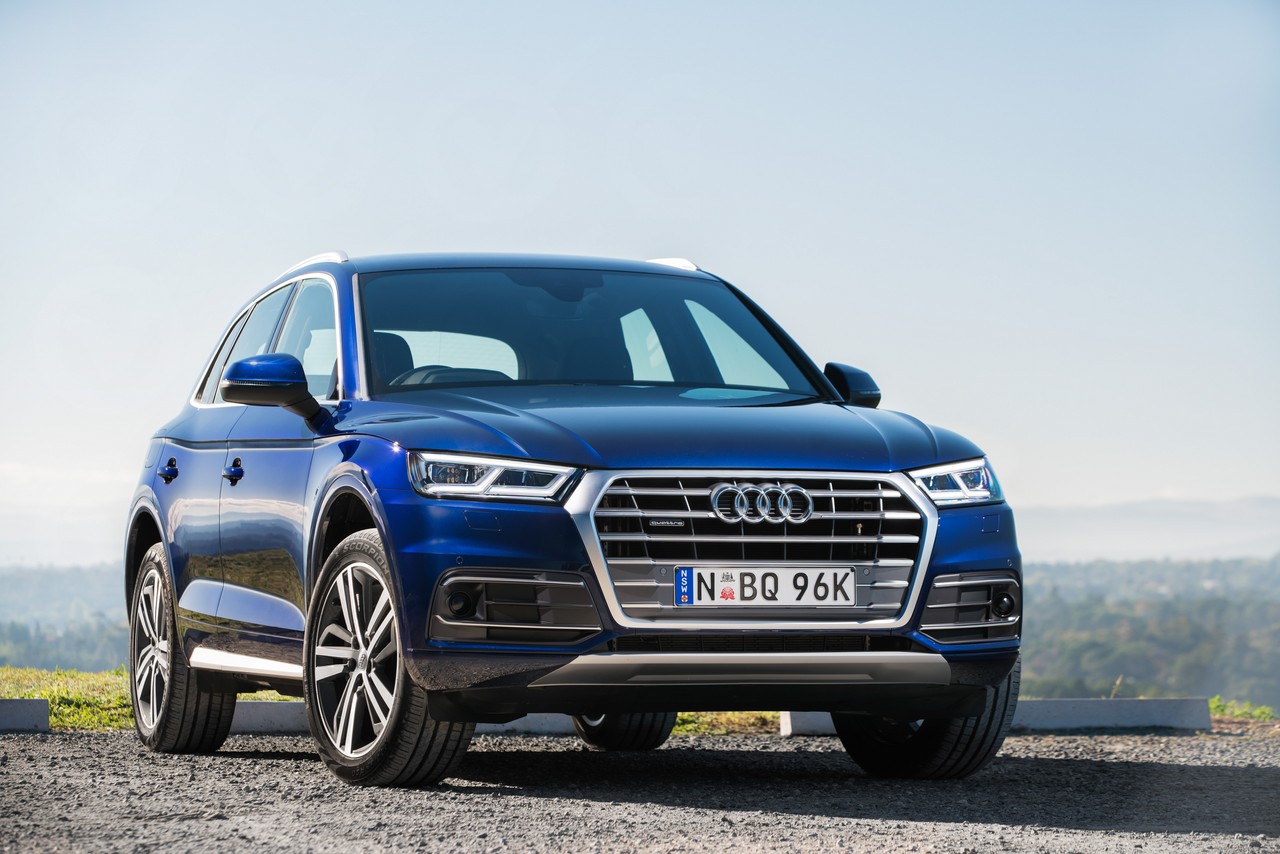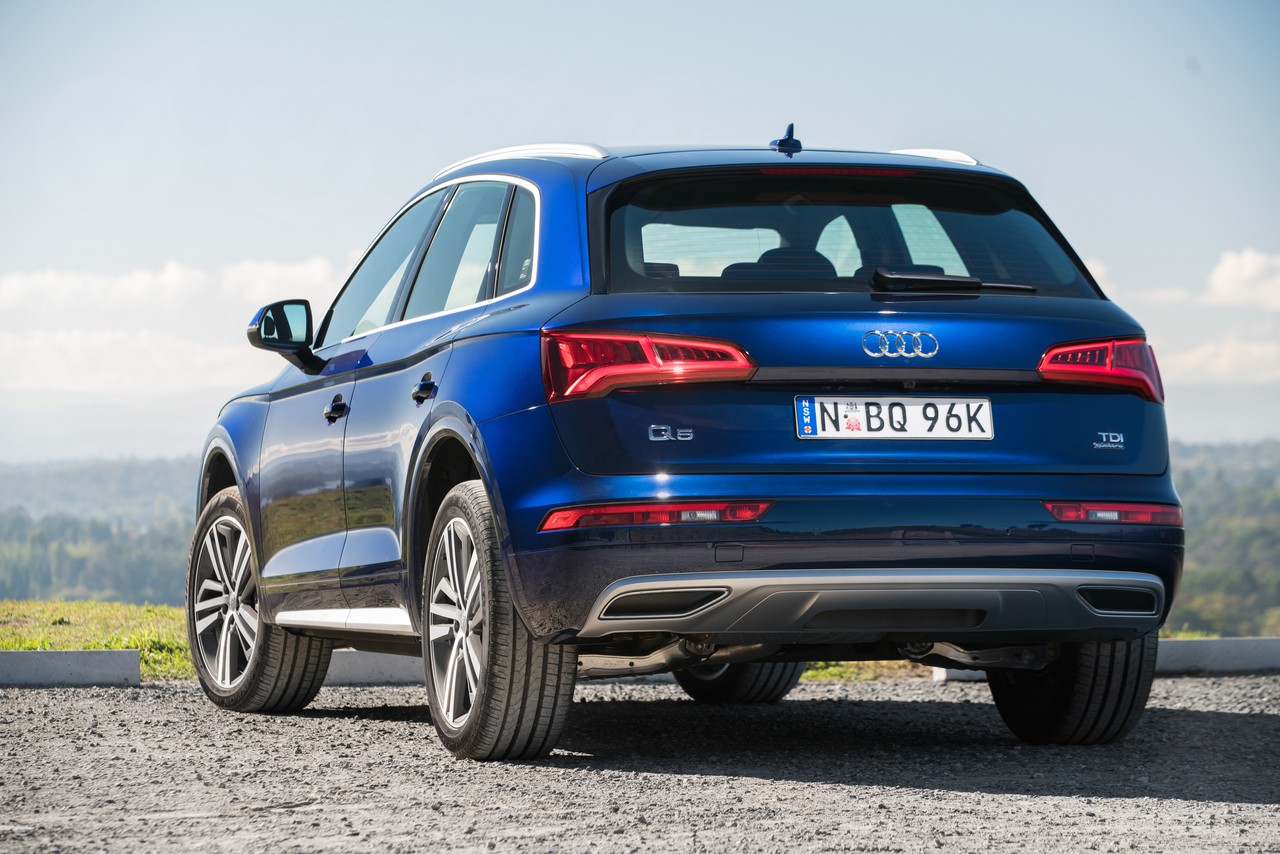
- Fuel-efficient powertrains
- Five star safety rating and active safety technologies
- Agile handling and reasonably composed ride on 18-inch wheels
- Mexican production has not affected Audi’s high standard of interior fit and finish
- Spacious interior, though sliding rear seats are optional
- Steering is overly assisted and lacking in feel
- Ride quality deteriorates on 20-inch wheels
- Dull styling
Overview
Released in Australia in June 2017, the Audi FY Q5 was a mid-size SUV. Manufactured in San José Chiapa, Mexico, the Audi FY Q5 range consisted of 2.0 TDI quattro and 2.0 TFSI quattro variants (see table below), both of which had seven-speed double clutch transmissions (Audi’s ‘S tronic’). Beyond this, the FY Q5 range included ‘design’ and ‘sport’ editions.
To reduce fuel consumption,
- Engines for the Audi Q5 had a ‘Start-Stop’ function which enabled them to shut down as the vehicle was coming to rest – this occurred at speeds of 7 km/h and below, except for the 3.0 TDI with Tiptronic (not offered in Australia) for which the threshold was 3 km/h; and,
- For models with double-clutch and automatic transmissions, a free-wheel function could disengage the engine from the driveline when travelling at speeds between 55 km/h and 160 km/h to reduce engine braking.
| Variant | Edition | Engine | Trans. | Peak power | Peak torque |
|---|---|---|---|---|---|
| 2.0 TDI quattro | design, sport |
1968 cc DETA turbo diesel I4 | 7sp DCT | 140 kW at 3800-4200 rpm | 400 Nm at 1750-3000 rpm |
| 2.0 TFSI quattro | sport | 1984 cc DAXB turbo petrol I4 | 7sp DCT | 185 kW at 5000-6000 rpm | 370 Nm at 1600-4500 rpm |
quattro with ultra technology
Both the FY Q5 2.0 TDI and 2.0 TFSI were fitted with Audi’s ‘quattro with ultra technology’ drivetrains. In normal driving conditions, the engine’s torque was directed to the front axle for maximum fuel efficiency. For front-wheel drive, a multi-plate clutch at the transmission outlet would be disconnected from the propshaft and an integrated decoupling clutch would open in the rear differential. As such, front wheel drive achieved greater fuel efficiency because the components which caused drag losses – such as the large crown wheel running in an oil bath – did not operate.
Networked throughout the vehicle, however, the quattro system acquired and evaluated data – such as steering angle, transverse and longitudinal acceleration, and engine torque – in 10 millisecond cycles. If there was a loss of traction, or such a loss was anticipated, then all-wheel drive would engage by:
- The multi-plate clutch would connect to the propshaft; and,
- The integrated decoupling clutch in the rear differential would close.
In the situation of fast cornering, the instant at which the inside front tyre reached its grip limit could be anticipated 0.5 seconds before it occurred.
Body and dimensions
The Audi FY Q5 was underpinned by Volkswagen Group’s ‘MLB evo’ platform. Compared to the Audi 8R Q5 , the FY Q5 was 34 mm longer (4663 mm), 5 mm narrower (1893 mm), 4 mm lower (1659 mm) and had an 11 mm longer wheelbase (2819 mm). The FY Q5 had an unladen mass around 90 kg less than its predecessor – the FY Q5 2.0 TFSI, for example, weighed 1720 kg – and mass reduction measures included:
- An extruded profile aluminium front cross-member ;
- Highly integrated cast aluminium parts for the front strut tower domes;
- An aluminium bonnet and tailgate; and,
- Hot-formed steels for 20 per cent of the body structure to re-inforce the transition from the front body to the interior, the front zone of the roof frame, the B-pillars, side sills and parts of the floor. Furthermore, many of the hot-formed body parts were tailored rolled blanks.
Four-cylinder Q5 models had a drag co-efficient of 0.30 Cd.
As an extra-cost option, the rear seats of the Audi FY Q5 could slide longitudinally (to vary legroom and luggage space) and had an adjustable seatback angle. Depending on the position of the rear seats, luggage compartment volume ranged from 550 litres to 610 litres, while luggage capacity with the rear seats folded down was 1550 litres.
Suspension
The Audi FY Q5 had five-link front suspension in which the upper links were integrated into the bodywork and the lower links were attached with rubber mounts to a hybrid steel/aluminium sub-frame. For the five-link rear suspension, the axle was insulated from the body by hydraulically damped axle mounts.
As an extra-cost option, the Audi Q5 was available with:
- ‘Damper control’ which consisted of electronically controlled dampers that could vary damping response according to the drive mode selected and driving conditions; and,
- Adaptive air suspension which could vary ride height over five stages. Compared to the standard steel suspension, air suspension could lower the body by 22 mm or raise it by up to 45 mm.
Steering
The Audi FY Q5 had rack-and-pinion steering with speed-sensitive electric power assistance; the steering ratio was 15.8:1, while the FY Q5 quattro had a turning circle of 11.7 metres. As an option, the Audi Q5 was available with ‘dynamic steering’ which varied the steering ratio according to driving speed and steering angle.
Safety equipment
Standard safety equipment for the Audi FY Q5 included dual front airbags, front and rear side airbags, full-length curtain airbags (i.e. for front and rear occupants), ABS, electronic brake force distribution, brake assist, electronic stability control, traction control and front seatbelts with pre-tensioners and load limiters.
As standard, the Audi FY Q5 was fitted with the following active safety technologies –
- Audi pre sense city: operating at speeds up to 85 km/h, Audi pre sense city used a windscreen-mounted front camera to scan the road for other vehicles and pedestrians. If there was a collision risk, the driver would receive a series of warnings. If the driver failed to respond, full braking force could be applied autonomously. From initial speeds of up to 40 km/h, collisions could be prevented; at higher speeds (up to 85 km/h), the severity of the collision was reduced;
- Audi pre sense basic: initiated occupant protection measures such as tightening the front seatbelts, closing the windows and activating the hazard lights when ‘unstable driving conditions’ were detected or a collision was anticipated;
- Audi pre sense rear: could warn of potential collisions from behind, alert following traffic by rapidly flashing the brake lights and activate the ‘Audi pre sense basic’ protection measures described above;
- Audi side assist: operating at speeds above 15 km/h, Audi side assist used two rear radar sensors to monitor traffic up to 70 metres behind the Q5. If another vehicle was approaching quickly or was in the driver’s blind spot, a warning LED in the housing of the appropriate door mirror would illuminate. If the driver activated the indicator to change lanes, the LED would blink rapidly to warn the driver;
- Rear cross-traffic assist: when reversing at low speeds, rear cross-traffic assist used the rear radar sensors to detect approaching traffic. If approaching traffic was detected which may cross the vehicle’s path, the driver would receive warnings (visual and acoustic) and be alerted by a brief, jolting application of the brakes;
- Exit warning: activated when the vehicle stopped moving, exit warning would alert occupants if vehicles were approaching from behind by illuminating red fibre optics in the door-opening mechanism as the doors were opened;
- Multi-collision brake: in the event of a collision, the multi-collision brake function provided ‘controlled application of the brakes’ to prevent the car from skidding and to reduce the risk and severity of secondary collisions; and,
- Attention assist: monitored driver behaviour and issued a warning if the driver was assessed to be ‘inattentive’.
The Audi Q5 2.0 TDI quattro sport and 2.0 TFSI quattro sport were further equipped with:
- Adaptive Cruise Control (ACC): using two front radar sensors and the camera, ACC could maintain a specified distance – from five selectable distances – between the Q5 and the vehicle ahead at speeds up to 250 km/h. Furthermore, ‘Audi drive select’ could be used to adjust the rate of acceleration and other control dynamics;
- Stop&Go function: an extension of the ACC and limited to models with automatic or double clutch transmissions, ‘Stop&Go’ operated at speeds of up to 60 km/h and could apply the brakes to bring the vehicle to rest. Once traffic began moving, the Audi Q5 would automatically accelerate;
- Traffic-jam assist: an extension of the ACC, the traffic-jam assist function could take control of steering operations at speeds up to 65 km/h on ‘well-developed roads when traffic is congested.’ To do so, traffic-jam assist used lane markings and other vehicles on the road for orientation. When the traffic-jam assist function reached its limits – for example, when traffic was sparse or there was a sharp corner ahead – the driver had to take over steering. Hence, the system provided warnings at different levels;
- Audi pre-sense front: could prevent front-to-rear collisions or reduce their severity. In hazardous situations, the driver received visual and acoustic warnings to apply the brakes, followed by a brief application of the brakes for a jolting effect to alert the driver;
- High beam assist: automatically switched between low and high beam headlights for improved visibility, using a sensor to determine when it was safe to do so (i.e. without dazzling other drivers); and,
- Turn assist: active at speeds from 2 km/h to 10 km/h, ‘turn assist’ could monitor oncoming traffic during right turns (for cars with right-hand drive). In hazardous situations, the brakes could be applied automatically to stop the vehicle. Turning assist commenced operation when the driver activated the right-hand turn signal.
The Audi FY Q5 also had an ‘active bonnet’ which deployed pyrotechnic charges in the event of a pedestrian collision to raise the height of the bonnet and locks to secure it to provide clearance over ‘hard points’ in the engine bay. In doing so, the likely severity of the pedestrian’s impact was reduced.
Euro NCAP testing
In Euro NCAP testing , the 2017 Audi FY Q5 received a five star safety rating which included a 93 per cent adult occupant protection rating and an 86 per cent child occupant protection rating. In the frontal offset test, occupant protection was generally rated as good though chest protection for the driver was rated as adequate (i.e. a slight risk of serious injury). While maximum points were awarded in the side impact, chest protection in the more severe pole test was rated as marginal.
Wheels, tyres and brakes
The Audi Q5 2.0 TDI quattro design had 8.0J x 18-inch alloy wheels with 235/60 R18 tyres, 338 mm by 30 mm ventilated front brake discs and 330 mm by 22 mm ventilated rear discs. As standard, the Audi Q5 was fitted with a space-saver spare wheel.
The Q5 2.0 TDI quattro sport and 2.0 TFSI quattro sport, however, had 8.0J 20-inch alloy wheels with 255/45 R20 tyres and 350 mm by 34 mm ventilated front brake discs.
Features: Audi Q5 2.0 TDI quattro design
The Audi FY Q5 was fitted with Audi’s second generation modular infotainment platform (‘MIB 2’). For Australia, the standard infotainment system for the Audi Q5 included an ‘Audi connect’ in-car Wi-Fi hotspot, ‘Audi music interface’ with two USB inputs and 3.5 mm auxiliary input socket, ‘Audi smartphone interface’ for integration with Apple or Android devices via USB, Bluetooth mobile phone connectivity with audio streaming and two SDXC card readers. The Audi Q5 design editions were also equipped with Audi’s ‘MMI navigation system’ which had a seven-inch high resolution colour display, 3D maps and integrated voice control.
Beyond this, standard features for the Audi Q5 2.0 TDI quattro design included an eight speaker sound system, digital radio tuner (DAB+), CD player, power adjustable front seats with four-way power adjustable lumbar support, leather upholstery, three-zone climate control air conditioning, cruise control with braking, xenon headlights, LED daytime running lights, dusk-sensing headlights, rain-sensing wipers, a leather-wrapped steering wheel, 40:20:40 split rear seats, remote central locking with proximity key, power adjustable door mirrors, power windows, tilt and telescopic steering wheel adjustment, an auto-dimming interior rear view mirror, push-button start, map lights, ambient lighting, ‘Aluminium rhombus’ interior inlays, floor mats (front and rear), tyre pressure loss indicator, a trip computer, an alarm and immobiliser.
The Audi Q5 2.0 TDI quattro design was also equipped with:
- ‘Audi parking system plus’ which included front and rear parking sensors, and a rear view camera and visual display; and,
- A power-operated tailgate which could be opened or closed with a kicking motion beneath the rear bumper.
Features: Audi Q5 2.0 TDI quattro sport and 2.0 TFSI quattro sport
Compared to the Q5 2.0 TDI quattro design, the 2.0 TDI quattro sport and 2.0 TFSI quattro sport were equipped with Audi’s ‘MMI navigation plus with MMI touch’ system which added:
- An MMI touch control panel with handwriting recognition and a touch function to re-position and zoom the displayed maps;
- A three year subscription for map updates;
- SUNA live traffic updates; and,
- A 10 GB flash memory for media storage.
As standard, the Q5 sport editions also added a 180 watt sound system with ten speakers (including subwoofer) and a six-channel amplifier, a CD/DVD player, front sport seats, LED headlights, heated door mirrors with folding and kerb-side functions, black cloth headlining and Audi’s ‘virtual cockpit’ (a 12.3-inch TFT display with 1440 x 540 pixel resolution rather than conventional analogue instrument dials).
Visually, the Audi Q5 sport editions could be identified by their ‘twilight grey’ radiator grilles with ‘aluminium silver’ blades, and body-coloured bumper sections. The LED tail-lights also had dynamic indicators which progressively illuminated light segments in the direction that the driver had indicated to turn.
2019 Audi Q5 45 TFSI Black Edition and Q5 50 TDI Black Edition
The Audi Q5 45 TFSI Black Edition and Q5 50 TDI Black Edition were released in Australia in April 2019. Visually, the Audi Q5 Black Edition models could be identified by their 21-inch alloy wheels, metallic paint finishes, ‘S line’ exterior package, illuminated ‘S line’ front door sill trims, rear privacy glass and high-gloss ‘titanium black’ exterior package (including black door mirrors and roof rails).
Inside, the Audi Q5 Black Editions added heated front seats (already standard for the Q5 50 TDI), a flat-bottom steering wheel and ambient lighting package with 30 selectable colours.
September 2019 update
From September 2019,
- Audi Q5 design editions were fitted – as standard – with two-tone 19-inch alloy wheels, MMI navigation plus with MMI Touch, Audi active lane assist and high beam assist;
- Audi Q5 40 TDI sport and 45 TFSI sport models were fitted with heated front seats, a driver’s seat memory function, a panoramic glass sunroof, parking assistance package (including a 360-degree camera) and auto-dimming door mirrors; and,
- The Audi Q5 50 TDI sport was equipped with Milano leather upholstery, a panoramic glass sunroof and ‘S line’ exterior package.
Brochure and specifications
- Specification Guide: Audi FY Q5 (June 2017)
- Specification Guide: Audi FY Q5 (September 2019)
- Technical Data: Audi Q5 2.0 TDI quattro S tronic (140 kW, April 2017)
- Technical Data: Audi Q5 2.0 TFSI quattro S tronic (185 kW, April 2017)
